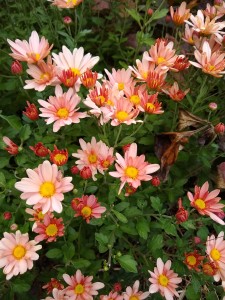 I used to mope over the advance of fall, lamenting the loss of my beloved garden flowers, morosely plucking the last roses, and generally carrying on as if horticultural Armageddon was just around the corner. I felt as if the Grim Reaper had stepped away from the neighbors’ lavish Halloween display to walk hand in hand with me as I cut back the endless swathes of bloomed-out asters and fading perilla mint. The only thing missing was artist Edward Gorey to immortalize the whole scene in the style of late Victorian mourning art.
I used to mope over the advance of fall, lamenting the loss of my beloved garden flowers, morosely plucking the last roses, and generally carrying on as if horticultural Armageddon was just around the corner. I felt as if the Grim Reaper had stepped away from the neighbors’ lavish Halloween display to walk hand in hand with me as I cut back the endless swathes of bloomed-out asters and fading perilla mint. The only thing missing was artist Edward Gorey to immortalize the whole scene in the style of late Victorian mourning art.
The asters will still be blooming for another week and the perilla mint is just hitting its stride, but until a few days ago I fully anticipated the usual descent into the autumnal malaise. Instead I had a major epiphany that changed my outloook and made me realize that fall is about expectation and preparation, not mourning.
This revelation hit me in a flash, but it had been gestating for a long time. Over the last few years, I have become increasingly aware of the equinoxes and solstices, those quarterly observances that have been used since ancient times to define agricultural seasons and mark the gradual changes in the hours of light and darkness. We passed the autumn equinox on September twenty-first and are heading towards the great winter solstice on or about the twenty-first of December. After that, daylight will gradually return—a joyous event that gardeners prepare for even as the daylight ebbs in fall.
All plants are daylight sensitive, though some, like the garden chrysanthemums, take it to extremes and wait until the days shorten substantially to even think about producing blooms. Their cousins, the garden center mums, would do the same thing, but wholesale growers trick them into early flowering by cleverly manipulating light and darkness. The asters, now thoroughly into their glorious flush of autumn bloom , will shine a bit longer before preparing for next year by setting seed and dispersing it with all their might. I used to put off cutting back my asters to save the seedheads for the birds. In the process I acquired hundreds of asters. Now I realize that just as the asters are prepping for next year by flinging seed to the four winds, I should be cutting back stalks. I am quite sure that there will still be plenty for avian visitors.
Since my epiphany I have felt unusually happy and creative in the garden. I imagine all the spring-flowering bulbs newly planted in the earth or resident since seasons past. Each tulip or daffodil already contains the embryo of the flower that will shoot up next spring, and needs only a bit of rest and gestation in cold garden soil to make that happen. The aster, morning glory, perilla, larkspur and other seeds flying about as I cut back the stalks will land on the ground and undergo cold stratification, a natural process necessary for spring germination. The cimicifuga, which is blooming now in honey-scented glory, is providing food to late season pollinators prior to setting seed for next year. A few of the roses are also feeding the pollinators by pushing out blooms, but the more sensible among them are setting hips that contain enough seeds to ensure the survival of their species.
Out of the corner of my eye, I see Art Wolk’s wonderful book, Bulb Forcing for Beginners and the Seriously Smitten. Forcing or artificially manipulating bulbs to bloom at a particular time is another way of preparing and looking ahead. I will buy some of the bagged bulbs that are currently clogging the aisles of every store in the area and set them aside for winter forcing. Wolk’s words and photos are inspiring–showing how easy it is to force bulbs with just a small amount of effort and forethought.
By skipping the lolling and lamentation that normally occupies my time as the growing season winds down, I will probably have the energy to get those bulbs organized and potted up for an inspiring indoor show in late winter.
Now that I have had the epiphany, the Grim Reaper will just have to sit, sulk and scare the local children from the comfort of the neighbors’ porch.
